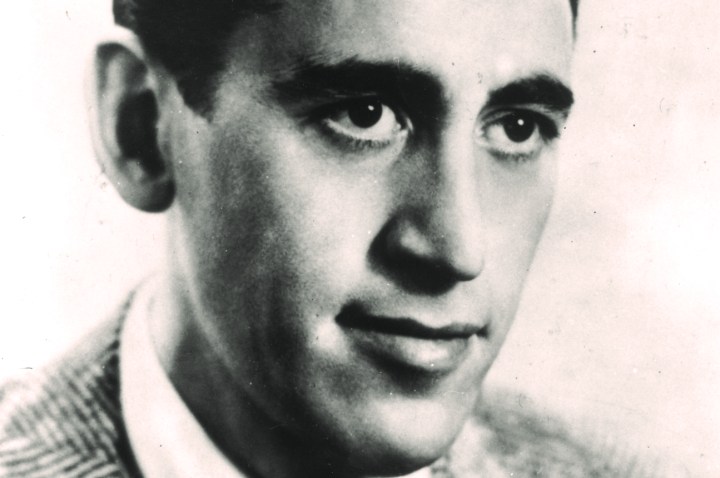Media
J. D. Salinger, troubadour for teen-aged angst, dies at age 91, following half a century of self-imposed exile

American author J.D. Salinger, the writer who gave an original voice to the rhythms of teen-age rebellion died Thursday in Cornish, New Hampshire, a small New England town he had made his home.
Jerome David Salinger burst onto the post-WWII New York literary scene with his short novel, The Catcher in the Rye, that had perfectly captured the sensibilities of 1950s teenager-hood. Ostensibly a simple tale about high school student Holden Caulfield’s journey homeward after being expelled from a boarding school, the story was somehow perfectly in sync with its readers and their time. The baby-boom generation embraced it, making it one of their classic, must-reads. Old-style guardians of “high culture” professed themselves shocked by its amoral character; the blue nooses in schools and public libraries despised it and sometimes banned it as a book that would lead young people astray. But readers loved it and read it, again and again.
As a story of a young man’s educational awakening, “Catcher” was a tale with a twist – the further Caulfield flees the world of learning and enters the shadows during his journey into New York City, the more he moves towards truth and understanding. Caulfield’s adventures – a combined picaresque and bildungsroman – and his excoriations of “the phonies” of the world created for his readers the perfect target they could rail against. Along the way, it became a subtle – or not so subtle – influence on generations of books and films that ranged from “A Separate Peace”, to “The Dead Poets Society” and then on to “The Graduate”.
In the years that followed, Salinger produced a slender stream of novellas and short stories that grew increasingly gnomic and inward looking – most of them first appearing in “The New Yorker” magazine. Many of these works were about an alter-ego family, the Glasses, whose brood of children were preternaturally bright, funny, creative – and troubled. The Glass children were the stars of an ongoing radio show, The Wise Child, but the twinned strains of an unconventional religiosity and a tendency towards suicide also lurked inside some of them. His last book, “Raise High the Roof Beam, Carpenters and Seymour,” came out in 1963 and his last published work of any kind, the short story “Hapworth 16, 1924,” appeared in The New Yorker some forty-five years ago.
As Salinger’s body of work slowly grew, increasingly his characters were people who gained truth through revelation and sudden insight. In some ways, this mirrored Salinger’s own journey from a fairly conventional, fairly secular, American Jewish upbringing to an embrace of Zen Buddhism, and then, finally, to a school of Hindu meditation and teaching.
Salinger’s early life was actually more complex than it might have seemed, perhaps explaining some of the unusual aspects of his stories and characters. His mother had hidden her Scots-Irish roots her entire life; his father, a foodstuffs manufacturer, had sent the young Salinger off to Austria to learn the wholesale meat import/export business. He barely escaped the Nazi anschluss of Austria. During World War II, Salinger took part in the Normandy landings and, while he was in Europe, he met Ernest Hemingway in Paris. During the war, Salinger also suffered a mild nervous collapse – an experience he seems to have drawn upon for his poignant short story, “For Esme, with love and squalor”. Mining personal experience again, he drew on memories of his time at the Valley Forge Military Academy (a boarding high school) for his first novel – “The Catcher in the Rye”.
The New York Times’ redoubtable critic, Michiko Kakutani has written of Salinger’s characters, “What really knocked readers out about ‘The Catcher in the Rye’ was the wonderfully immediate voice that J D Salinger fashioned for Holden Caulfield….Salinger had such unerring radar for the feelings of teenage angst and vulnerability and anger that ‘Catcher,’ published in 1951, remains one of the books that adolescents first fall in love with.”
As his literary fame grew, Salinger withdrew further and further from the New York City literary life – moving eventually to a comfortable but not ostentatious home in the small New England town of Cornish, New Hampshire. Townspeople increasingly drew a protective ring around him – warding off inquisitive strangers and allowing him to lead his own life as he saw fit.
The local grocery store saved a week’s worth of New York Times for him to buy when he did his shopping; if he attended local university basketball games, people left him alone; and his neighbours gave outsiders misleading directions to his home so that he wouldn’t be bothered by unwanted visitors. Persistent rumours also say Salinger had created a whole corpus of writing but had decided not to release it.
As a result, while his best work will undoubtedly be reissued in commemorative editions, the next chapter will be over his literary legacy – what manuscripts has he left behind? Who owns them, how and when will they be published? Or, has Salinger already had the last laugh and left firm instructions to destroy anything he hasn’t already fed into the fireplace? So far, his literary representative and his publisher are mum on the subject. And Salinger himself had told an interviewer from the New York Times earlier, “There is a marvellous peace in not publishing. Publishing is a terrible invasion of my privacy. I like to write. I love to write. But I write just for myself and my own pleasure.”
By Brooks Spector
Read more: The New York Times, Vanity Fair, New York Times
Watch: PBS on the death of JD Salinger

















 Become an Insider
Become an Insider